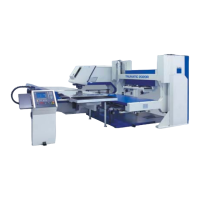Do you have a question about the Trumpf TruPlasma RF 1002 and is the answer not in the manual?
Overview of safety measures and general precautions for generator operation.
Measures for avoiding potential dangers and overview of residual dangers.
Specifies requirements for personnel performing installation, operation, configuration, and maintenance.
Details the hazards associated with high voltages and protective measures.
Explains the risks from electromagnetic fields and manufacturer's protective measures.
Provides crucial operational notes and safety inspections for operators.
Outlines immediate actions to be taken in case of an emergency.
Provides detailed specifications for the generator's RF output power.
Specifies the accuracy of the output power for digital and analog control.
Details the output power accuracy when controlled digitally.
Details the output power accuracy when controlled via analog input.
Details the electrical connection requirements and specifications for the mains power.
Details the requirements for the cooling water circuit, including specifications and parameters.
Describes the standard and customer variants of the RS-232/RS-485 interface, including pin assignments and cable requirements.
Details the standard interface connection, pin assignment, and cable requirements.
Explains the customer variant RS-232 interface, including pin assignment and cable requirements.
Covers the AD interface, including its view, cable requirements, connection, and signal meanings.
Details the pin assignment and signal descriptions for the standard AD interface.
Provides pin assignment and signal descriptions for AD interface variant 1.
Details pin assignment and signal descriptions for AD interface variant 2.
Provides pin assignment and signal descriptions for AD interface variant 3.
Details the mains input connection and pin assignment.
Describes the RF output connectors and cable requirements.
Provides details on cooling water connections, including view and connection type.
Defines the ASIP protocol for serial data transmission, including bit transmission and framing.
Details the RS-232/RS-485 interfaces, including bit transmission, settings, and addressing.
Covers the general installation procedures, including module fastening.
Provides comprehensive instructions for connecting and managing the generator's cooling water system.
Details the procedure for connecting the RF output, including safety precautions.
Covers the connection of the mains cable and supply voltage requirements.
Provides step-by-step instructions for safely dismantling the generator.
Outlines the procedure for disposing of the generator in compliance with local regulations.
Describes how to activate and switch between different interfaces for controlling the generator.
Provides instructions for operating the generator using the TruControl Power software.
Step-by-step guide for installing the TruControl Power software on a computer.
Details the process of establishing a connection to the generator via the RS-232 interface.
Details the procedure for switching the generator's power on and off using TruControl Power.
Guides on operating the generator using RS-232/RS-485 interfaces, including switching between modes.
Details how to operate the generator using the AD interface, including scaling analog signals.
Covers power regulation, including switching power on and regulating power.
Covers essential maintenance tasks, including software updates and cooling water checks.
Specifies the parameters to check for ensuring proper cooling water quality.
Explains fault indication, alarm messages, warning messages, and how to reset them.
Provides a comprehensive list of error, warning, and information messages with their causes and measures.
| Frequency | 13.56 MHz |
|---|---|
| Generator Type | RF Generator |
| Output Power | 10 kW |
| Cooling Type | Air-cooled |
| Mounting | 19-inch rack |










